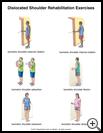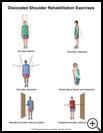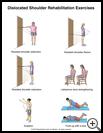
Shoulder Dislocation Exercises
Do these exercises as soon as your healthcare provider says you can.
- Isometric shoulder external rotation: Stand in a doorway with your elbow bent 90 degrees and the back of the wrist on your injured side pressed against the door frame. Try to press your hand outward into the door frame. Hold for 5 seconds. Do 2 sets of 15.
- Isometric shoulder internal rotation: Stand in a doorway with your elbow bent 90 degrees and the front of the wrist on your injured side pressed against the door frame. Try to press your palm into the door frame. Hold for 5 seconds. Do 2 sets of 15.
- Isometric shoulder adduction: With a pillow between your chest and your arms, squeeze the pillow with your arms and hold 5 seconds. Do 2 sets of 15.
- Isometric shoulder flexion: Stand facing a wall with the elbow on your injured side bent 90 degrees and held close to your body. Press your fist forward against the wall. Hold this for 5 seconds, then rest. Do 2 sets of 15.
- Isometric shoulder extension: Stand facing away from the wall with the elbow on your injured side touching the wall. Press the back of your elbow into the wall and hold for 5 seconds. Rest. Do 2 sets of 15.
- Isometric shoulder abduction: Stand with your injured side next to the wall and your elbow bent 90 degrees. Press the side of your arm into the wall as if you were trying to lift it. Hold for 5 seconds. Rest. Do 2 sets of 15.
- Shoulder flexion: Stand with your arms hanging down at your side. Keep your elbows straight and lift your arms up over your head as far as you can reach. Hold this position for 5 seconds. Do this 10 times.
- Shoulder extension: Stand with your arms at your sides. Move the arm on your injured side back, keeping the arm straight. Hold this position for 5 seconds. Return to the starting position and repeat 10 times.
- Shoulder abduction: Stand with your arms at your sides. Bring your arms up, out to the side, and toward the ceiling. Hold for 5 seconds. Return to the starting position. Repeat 10 times.
- Active elbow flexion and extension: Gently bring the palm of the hand on your injured side up toward your shoulder, bending your elbow as much as you can. Then straighten your elbow as far as you can. Repeat 15 times and do 2 sets of 15.
As these exercises become easier, add a weight to your hand to give you some resistance.
- Resisted shoulder internal rotation: Stand sideways next to a door with your injured arm closest to the door. Tie a knot in the end of the tubing and shut the knot in the door at waist level. Hold the other end of the tubing with the hand of your injured arm. Bend the elbow of your injured arm 90 degrees. Keeping your elbow in at your side, rotate your forearm across your body and then back to the starting position. Make sure you keep your forearm parallel to the floor. Do 2 sets of 15.
- Resisted shoulder external rotation: Stand sideways next to a door with your injured arm farther from the door. Tie a knot in the end of the tubing and shut the knot in the door at waist level. Hold the other end of the tubing with the hand of your injured arm. Rest the hand of your injured arm across your stomach. Keeping your elbow in at your side, rotate your arm outward and away from your waist. Make sure you keep your elbow bent 90 degrees and your forearm parallel to the floor. Repeat 10 times. Build up to 2 sets of 15.
- Resisted shoulder adduction: Stand sideways next to a door with your injured side closer to the door. Stand about a shoulder's length from the door. Tie a knot in the end of the tubing and shut the knot in the door at shoulder height. Hold the tubing with the hand on your injured side at shoulder height. Slowly pull the tubing down toward your side. Do 2 sets of 15.
- Resisted shoulder flexion: Holding tubing connected to a door knob at waist level, face away from the door, keep your elbow straight and pull your arm forward. Do 2 sets of 15.
- Resisted shoulder extension: Stand facing a door. Tie a knot in the end of the tubing and shut the knot in the door at shoulder height. Use the hand on your injured side to hold the tubing at shoulder height. Pull your arm back, keeping your arm straight. Do 2 sets of 15.
- Latissimus dorsi strengthening: Sit on a firm chair. Place your hands on the seat on either side of you. Lift your buttocks off the chair. Hold this position for 5 seconds and then relax. Repeat 15 times. Do 2 sets of 15.
- Scaption: Stand with your arms at your sides and with your elbows straight. Slowly raise your arms to eye level. As you raise your arms, spread them apart so that they are only slightly in front of your body (at about a 30-degree angle to the front of your body). Point your thumbs toward the ceiling. Hold for 2 seconds and lower your arms slowly. Do 2 sets of 15. Progress to holding a soup can or light weight when you are doing the exercise and increase the weight as the exercise gets easier.
- Push-up with a plus: Begin on the floor on your hands and knees. Keep your arms a shoulder width apart and lift your feet off the floor. Arch your back as high as possible and round your shoulders (this is the "plus" part or the exercise). Bend your elbows and lower your body to the floor. Return to the starting position and arch your back again. Do 2 sets of 15.
Written by Tammy White, MS, PT, and Phyllis Clapis, PT, DHSc, OCS, for RelayHealth.
Pediatric Advisor 2012.2 published by RelayHealth.
Last modified: 2011-04-29
Last reviewed: 2011-12-30
Last modified: 2011-04-29
Last reviewed: 2011-12-30
This content is reviewed periodically and is subject to change as new health information becomes available. The information is intended to inform and educate and is not a replacement for medical evaluation, advice, diagnosis or treatment by a healthcare professional.
© 2012 RelayHealth and/or its affiliates. All rights reserved.



